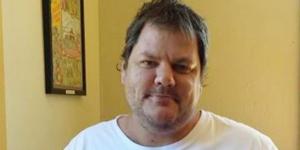Ian Fackender,47,was lying in bed listening to loud music through headphones on the evening of August 30,2017,when police let themselves in with a key because he had not received his monthly anti-psychotic injection and did not answer the door.

Ian Fackender was shot dead by police in 2017.Supplied
Fackender,who had schizophrenia,had experienced a significant deterioration in his condition including delusions about police and demons. He had a fear that police were going to arrest him and take him to prison,and was lying under his doona holding a sword.
When two officers burst into his room about 7.20pm,one brandished a Taser and said “show me your hands” before pulling the doona away. Fackender responded by standing up and brandishing the sword.
The first officer attempted to use the Taser,which did not work,and the second officer tripped over as he tried to move away. As Fackender approached,the officer believed he was going to be hit with the sword,so he shot four times.
An ambulance was called,but Fackender was declared dead at 8.16pm.

Ian Fackender’s family outside the Coroner’s Court at Lidcombe on Tuesday. From left:Rachel Mangan (niece),Bronwyn Mangan (sister),Jeremy Slatcher (stepfather),Sue Slatcher (mother),Mavis Robinson (father’s partner) and Peter Fackender (father).Nick Moir
In findings on Tuesday,State Coroner Teresa O’Sullivan said there was a complete lack of communication between police at the scene,with each having a different understanding of what was happening,and a lack of communication between police and local mental health staff about the role police should play.
The officers who burst into the room developed a quick and “seriously flawed” plan while standing outside the bedroom door,the Coroner said.

Ian Fackender was listening to music when police entered his bedroom.Supplied
“The officers did not attempt to turn on a light or maintain a safe reactionary gap from Ian. Due to their lack of planning,they had no idea of the internal layout of the apartment or the location of the light switches,” O’Sullivan said.
“Their conduct in shining a light in Ian’s face and shouting ‘police’,while consistent with their training,would no doubt have terrified Ian given his entrenched fears about police and his mental state at the time.”
O’Sullivan could not determine whether Fackender knew the people in his room were police,but said “it is likely that he was acting under an honest belief that he was under attack and his life was in danger”.
“Had a mental health worker or family member been present at the scene,they might have been able to better manage the situation,” O’Sullivan said.
“I accept the submission made by Ian’s family and by counsel assisting that Ian’s death was ‘anything but inevitable’ and accordingly find that Ian’s death was preventable.”
Fackender had been subject to a community treatment order which required him to take his medication and attend appointments. When he failed to receive his injection several days earlier,staff at Bathurst community mental health services contacted police.
Officers at Bathurst police station were given a breach order,a document that allows them to apprehend a mentally ill person and bring them to hospital for treatment. The court heard the usual practice was for police to locate the person,then call mental health staff and attend at the location together.
However,this was not done. Police initially went to Fackender’s home at Kelso,a suburb of Bathurst,at 2.49pm,but he did not appear to be home.
They returned at 6.39pm,banging on his windows and spotting him inside under his doona. A real estate agent arrived at 7.16pm to give them a key,and they let themselves in a short time later.
A sergeant who had received four-day mental health training was aware police planned to interact with Fackender but remained at the station.
Fackender had previously been Tasered and pepper sprayed by police in September 2016 when his mental health deteriorated and he went outside his house with a loaded bow and arrow because he believed people were laughing at him.
O’Sullivan said the officer who shot Fackender was in fear for his life,and the use of his weapon was warranted,but it is “deeply regrettable” that he found himself in that situation at all.
“The lack of communication about when and how the operation should be carried out was a contributing factor to Ian’s tragic death,” she said. “I extend my sincere condolences to Ian’s family for their loss.”
She made numerous recommendations,including that a mental health memorandum of understanding between police,NSW Ambulance and NSW Health be comprehensively reviewed;and that a forensic psychiatrist examine the NSW Police weapons and tactics training curriculum within six months to advise how mental health considerations can be integrated.
O’Sullivan also recommended that Attorney-General Mark Speakman consider amending sections 58 and 59 of the Mental Health Act to allow greater flexibility in responding to patients who need to be located and transported by police after failing to comply with community treatment.
“Consideration of any reform should include how principles relating to the rights and dignity of mentally ill people and restraint as a last resort can be safeguarded if service requirements are modified or removed,” O’Sullivan said.
She said consideration should be given to removing the word “apprehend” from section 59 of the Act,which currently states that police can “apprehend and take,or assist in taking” a person to a mental health facility who requires treatment.
Fackender’s relatives were in court on Tuesday for the findings to be delivered. He was remembered as a warm and gentle soul who enjoyed chatting to his neighbours,tending to the garden,and working with computers.
His mother Sue Slatcher said her son’s admission to hospital was not an emergency situation,and if a mental health clinician and an ambulance officer had also responded to the scene he would almost certainly be alive.
She said her family has been left devastated by his death,and she hopes the recommendations will lead to better care for mentally ill members of the community.
The Morning Edition newsletter is our guide to the day’s most important and interesting stories,analysis and insights..